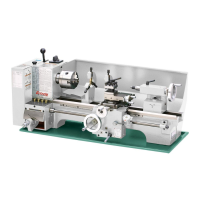-24-
Model G4000 (Mfg. Since 8/09)
5. Tighten each jaw in small increments in
an opposing sequence, as illustrated in
Figure 22, until the workpiece is firmly secure
in the desired position.
1
2
3
4
x
Figure 22. Opposing tightening sequence for the
4-jaw chuck.
6. Make fine adjustments to the workpiece posi-
tion by using a test indicator mounted on a
magnetic base and adjusting the jaws until
the workpiece is precisely aligned for your
operation (see Figure 23 for an example).
Note: Refer to ACCESSORIES on Page 43
for test indicator options from Grizzly.
Figure 23. Example of using a test indicator to
precisely align a non-concentric workpiece.
Test
Indicator
Magnetic
Base
Always use a low spindle speed when
machining non-concentric or off-center
workpieces to reduce the risk of ejecting the
workpiece from the holding device at a high
rate of speed. Failure to heed this warning
could lead to serious personal injury, death
or property damage.
Faceplate
The faceplate is used to hold non-concentric and
off-center parts. Although more versatile in mount-
ing these types of workpieces than the 4-jaw
chuck, it requires more work to properly clamp the
workpiece (see Figure 24 for an example).
Figure 24. Example of a non-concentric
workpiece clamped to a faceplate.
Clamps
NOTICE
You must use a minimum of three inde-
pendent clamping devices when using the
faceplate to hold a workpiece. Refer to
ACCESSORIES on Page 43 for clamping
options from Grizzly.

